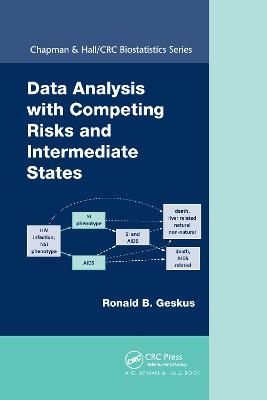
Data Analysis with Competing Risks and Intermediate States
Seiten
2020
Chapman & Hall/CRC (Verlag)
978-0-367-73805-1 (ISBN)
Chapman & Hall/CRC (Verlag)
978-0-367-73805-1 (ISBN)
- Titel z.Zt. nicht lieferbar
- Versandkostenfrei innerhalb Deutschlands
- Auch auf Rechnung
- Verfügbarkeit in der Filiale vor Ort prüfen
- Artikel merken
This practical and thorough book explains when and how to use models and techniques for the analysis of competing risks and intermediate states. It covers the most recent insights on estimation techniques and discusses in detail how to interpret the obtained results. Each chapter includes standard exercises; a software section on SAS, Stata, and
Data Analysis with Competing Risks and Intermediate States explains when and how to use models and techniques for the analysis of competing risks and intermediate states. It covers the most recent insights on estimation techniques and discusses in detail how to interpret the obtained results.
After introducing example studies from the biomedical and epidemiological fields, the book formally defines the concepts that play a role in analyses with competing risks and intermediate states. It addresses nonparametric estimation of the relevant quantities. The book then shows how to use a stacked data set that offers great flexibility in the modeling of covariable effects on the transition rates between states. It also describes three ways to quantify effects on the cumulative scale.
Each chapter includes standard exercises that reflect on the concepts presented, a section on software that explains options in SAS and Stata and the functionality in the R program, and computer practicals that allow readers to practice with the techniques using an existing data set of bone marrow transplant patients. The book’s website provides the R code for the computer practicals along with other material.
For researchers with some experience in the analysis of standard time-to-event data, this practical and thorough treatment extends their knowledge and skills to the competing risks and multi-state settings. Researchers from other fields can also easily translate individuals and diseases to units and phenomena from their own areas.
Data Analysis with Competing Risks and Intermediate States explains when and how to use models and techniques for the analysis of competing risks and intermediate states. It covers the most recent insights on estimation techniques and discusses in detail how to interpret the obtained results.
After introducing example studies from the biomedical and epidemiological fields, the book formally defines the concepts that play a role in analyses with competing risks and intermediate states. It addresses nonparametric estimation of the relevant quantities. The book then shows how to use a stacked data set that offers great flexibility in the modeling of covariable effects on the transition rates between states. It also describes three ways to quantify effects on the cumulative scale.
Each chapter includes standard exercises that reflect on the concepts presented, a section on software that explains options in SAS and Stata and the functionality in the R program, and computer practicals that allow readers to practice with the techniques using an existing data set of bone marrow transplant patients. The book’s website provides the R code for the computer practicals along with other material.
For researchers with some experience in the analysis of standard time-to-event data, this practical and thorough treatment extends their knowledge and skills to the competing risks and multi-state settings. Researchers from other fields can also easily translate individuals and diseases to units and phenomena from their own areas.
Ronald B. Geskus is an associate professor at the Academic Medical Center in Amsterdam. He received a Ph.D. in mathematics from the Delft Technical University. His main research interests include competing risks and multi-state models, prediction of events based on time-updated marker values, and causal inference.
Basic Concepts. Competing Risks; Nonparametric Estimation. Intermediate Events; Nonparametric Estimation. Regression; Cause-Specific/Transition Hazard. Regression; Translation to Cumulative Scale. Epilogue. Bibliography. Appendix: Answers to Exercises. Index.
| Erscheinungsdatum | 16.01.2021 |
|---|---|
| Reihe/Serie | Chapman & Hall/CRC Biostatistics Series |
| Sprache | englisch |
| Maße | 156 x 234 mm |
| Gewicht | 520 g |
| Themenwelt | Mathematik / Informatik ► Mathematik |
| Studium ► Querschnittsbereiche ► Epidemiologie / Med. Biometrie | |
| Naturwissenschaften ► Biologie | |
| Sozialwissenschaften | |
| ISBN-10 | 0-367-73805-8 / 0367738058 |
| ISBN-13 | 978-0-367-73805-1 / 9780367738051 |
| Zustand | Neuware |
| Haben Sie eine Frage zum Produkt? |
Mehr entdecken
aus dem Bereich
aus dem Bereich
ein überfälliges Gespräch zu einer Pandemie, die nicht die letzte …
Buch | Hardcover (2024)
Ullstein Buchverlage
24,99 €


